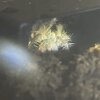- Joined
- Oct 4, 2021
- Messages
- 115
Last week, I fed my ~2 inch T. apophysis sling. All seemed fine except I couldn’t locate the bolus the next day - which sometimes happens if it doesn’t yeet it out of burrow under its hide. Whatever. I figured I’d get it sometime that it wasn’t in the hide/burrow.
I’m feeding 1 small/medium cricket twice a week at the moment and planning to go down to one large a week once it’s big enough. (Although it probably COULD take it down with the insanity of its feeding response, I’m not risking it.)
This seemed like a fine plan until yesterday’s feeding when I shone a flashlight into the enclosure before opening it so I knew where the T was and I saw a mound of fuzz behind a hump of substrate that the T built that I figured was mold. I wasn’t going to leave it, so I took my tongs and pulled it out. When I removed it, I realized it was a mangled, but not eaten, cricket and there was another dead cricket (this one was headless) next to it that was also hidden by substrate. I don’t know how long it’s been doing this or if there are more carcasses in the hide.
I did a search and saw that this is relatively normal behavior if the T is in premolt or just isn’t hungry - but what if there’s another dead cricket under there that I missed? Should I move the hide and do a full check for any dead crickets and just cut back feedings for a while?
Secondary question is about slowing down the food offerings. When I do offer prey, how can I make sure it’s actually being eaten without constantly disturbing the hide?
sorry for the awful abdomen shot. It never comes out of its hide when I’m around unless it’s hunting and it tackles prey and takes it back to its hide in the blink of an eye, so I don’t think I could get a good shot of it during that time.
I’m feeding 1 small/medium cricket twice a week at the moment and planning to go down to one large a week once it’s big enough. (Although it probably COULD take it down with the insanity of its feeding response, I’m not risking it.)
This seemed like a fine plan until yesterday’s feeding when I shone a flashlight into the enclosure before opening it so I knew where the T was and I saw a mound of fuzz behind a hump of substrate that the T built that I figured was mold. I wasn’t going to leave it, so I took my tongs and pulled it out. When I removed it, I realized it was a mangled, but not eaten, cricket and there was another dead cricket (this one was headless) next to it that was also hidden by substrate. I don’t know how long it’s been doing this or if there are more carcasses in the hide.
I did a search and saw that this is relatively normal behavior if the T is in premolt or just isn’t hungry - but what if there’s another dead cricket under there that I missed? Should I move the hide and do a full check for any dead crickets and just cut back feedings for a while?
Secondary question is about slowing down the food offerings. When I do offer prey, how can I make sure it’s actually being eaten without constantly disturbing the hide?
sorry for the awful abdomen shot. It never comes out of its hide when I’m around unless it’s hunting and it tackles prey and takes it back to its hide in the blink of an eye, so I don’t think I could get a good shot of it during that time.
Attachments
-
330.6 KB Views: 22


